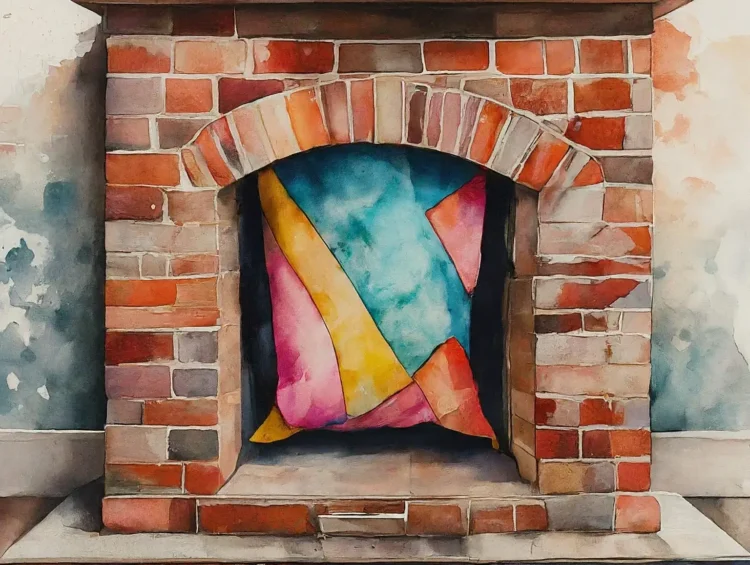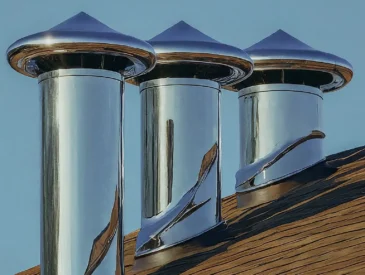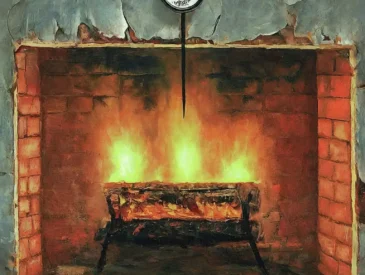Blocking off a chimney from inside your home is a decision some homeowners make, but they might be unsure about the process. So, how do you block a chimney from inside your home? Why should you do so?

A chimney can be blocked from inside the home with a fireplace balloon or fireplace glass door. You can also go the DIY route and block off your chimney using a plastic garbage bag and insulated material. Some homeowners choose to do this to prevent a fireplace draft or leak.
If you’re considering blocking off a chimney, you’re in the right place. This post will guide you through what it means to block a chimney, list three methods of how to do it, and explain why you may want to block your chimney from the inside. We’ll also talk about the safety of blocking your chimney temporarily and permanently.
How To Block A Chimney From The Inside
You can block off a chimney from the interior of your home in three ways: using a fireplace balloon, a fireplace glass door, or insulating material wrapped in plastic garbage bags. Some homeowners choose to block their chimneys because they no longer make use of them.
If you no longer use your fireplace, a chimney is nothing more than a hole in your house. Warmth can escape from here, so blocking it off seems like the obvious choice.
Drafts and leaks can also be significant push factors for deciding to block a chimney up.
What Is Blocking a Chimney?
Blocking a chimney is when something prevents or “blocks” air, smoke, water, and debris from escaping into or outside the home through the chimney.
The chimney acts as a passageway between a house and the outside elements. Therefore, blocking it off can make the maintenance of a fireplace minimal.
This minimizes the soot, creosote, and debris cleanup that comes with traditional fireplace and chimney maintenance.
Of course, how much maintenance your setup requires depends on the type of fireplace you have. With that being said, blocking off a chimney can be permanent if you choose to fill up the space with stacked bricks.
There are non-permanent options you can use should you decide you want to enjoy your chimney now and then. These are called flue sealers. A fireplace balloon is a flue sealer.
Related: flue temperature guides
Why Should You Block a Chimney From Inside?
There are several reasons why you may want to block your chimney from inside your home. These reasons may include the hassle of upkeep or you no longer enjoy it.
Or, you’ve noticed your home loses energy through the chimney. The latter can mean wasted money on heating and cooling costs for you.
Here are several reasons why you may want to consider blocking your chimney:
Maintenance can be a hassle: You already know that having a fireplace and chimney is a lot of work. For example, you have to get fuel.
There are also dampness concerns, ashes, and soot cleanup. Blocking up your chimney, if only every so often, can lessen the maintenance needed from you.
You no longer enjoy the fireplace: If you aren’t using the fireplace regularly, it’s an excellent time to consider blocking off the chimney. Remember, having a chimney inside loses energy.
A fireplace can lose energy: The chimney exhausts heat from the fireplace. This carries air from inside your home outward, causing your home to lose energy (heat and A/C). Drafts drive up the cost of cooling and heating in your home.
A fireplace can take up space: If a fireplace is taking up too much space in a room, you may want to block off the chimney and close off the fireplace opening. A sealed or blocked-off fireplace and hearth give more room to move furniture against a wall.

Is it safe to block a Chimney?
It is safe to block a chimney as long as you do so correctly. But, blocking off a chimney can cause problems inside the flue, fireplace, and chimney from condensation – aka moisture. Sealed-off chimneys still need to be maintained, cleaned, and vented.
How does moisture build up inside your chimney? Temperature differences inside your chimney cause damp air to condense, meaning a change from gas (air) to liquid (water).
This moisture-heavy air then seeps through the porous mortar joints. After that, moisture is wicked through the fireplace’s foundation that has contact with the ground.
If the fireplace opening is blocked off with an airtight surface, this can cause condensation problems inside your chimney. This can be an annoyance to fix.
Can I block off my chimney temporarily?
While you can block off your chimney temporarily—or whenever you are not using it—it may be best to leave your chimney unblocked.
Related: Chimney Fire Prevention
Blocking or closing off a chimney temporarily isn’t the best because blocking it off takes away the chimney’s equilibrium of intake and output air.
That flow of air maintains the physical properties inside the chimney. Water from rain can still collect inside the chimney and fireplace, even when it’s blocked off. A buildup of water can cause a slew of condensation issues.
Related: prevent the chimney from water
Blocking your chimney would prevent proper ventilation, which could lead to all the condensation issues we discussed.
How Do You Block a Chimney From Inside?
You can block a chimney from the inside using a fireplace balloon or a fireplace glass door that fits over the opening. You can also use insulating material (such as fiberglass) and plastic garbage bags to make a chimney-blocking device yourself that is less costly and easier to make.
Here’s a general how-to overview of blocking a chimney:
General Steps
- Determine how long you want the chimney blocked (permanently or intermittently)
- Put a flue cap on top of the flue
- Insulate the chimney bottom
- Seal the clean-out
Fireplace Balloon: If you want to go the store-bought route and don’t want to DIY, a fireplace balloon is your most straightforward option for blocking off your chimney.
Their design keeps air from escaping your home and prevents outside air from coming in. So, a fireplace balloon can help conserve your home’s energy.
But how do chimney balloons work? Chimney balloons are designed to inflate (usually by a plug-in wall outlet) and press against all four sides of your chimney so that it’s big enough to hold itself in place.
A ventilation gap on the side of the balloon allows some airflow, which allows the chimney to “breathe” and not become so damp. Fireplace balloons cost around $50.
Fireplace Glass Door
A fireplace glass door can also serve as an effective way to block off your chimney. As the name suggests, it’s a glass door that you can open and close. This would still allow for some airflow so that your chimney can breathe, but by simply closing the doors, your chimney is sealed off.
These usually run higher than fireplace balloons, with the cheaper models starting around $150–$200. In either instance of a fireplace balloon or a glass door, you’ll have to measure your fireplace!
The DIY Route: You can easily make your chimney blocker using items you already have around the house. Grab two plastic garbage bags and some insulation (such as fiberglass or Rockwool), and wrap the insulation inside one garbage bag. Only put insulation inside the bag. Use heavy, durable plastic bags (like contractor bags), and avoid using flimsy lightweight ones for your kitchen trash. Then, tie





